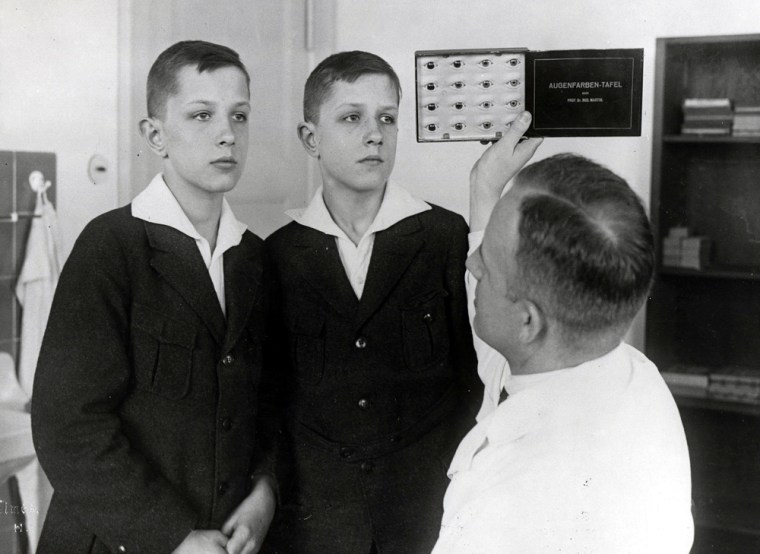A first-of-its-kind U.S. exhibit documents how the Nazis attempted to create a “master race,” from murder and forced sterilizations to the less violent urgings of “10 Commandments for Choosing a Mate.”
By the time the Nazis arose last century in Germany, biologists had shown that genes can determine a baby’s hair and eye color. From that, the Nazis argued that eliminating what they called the inferior genes of the “Jewish race” or the “Gypsy race” would help develop Germans into a master race to rule the world.
One of the exhibits at the U.S. Holocaust Memorial Museum shows a metal case with 20 glass eyes and a skin color chart.
“Deadly Medicine: Creating the Master Race” opens on Thursday. The museum says it’s the first exhibit in the United States to deal with the subject.
The Nazi version of genetics was out of date long before they took power. But they pressed ahead, blending political racism with science.
“Nazism is applied biology,” said Rudolf Hess. Adolf Hitler’s deputy.
The Nazis furthered the development of what they promoted as a blue-eyed, golden-haired master race by issuing documents like “10 Commandments for Choosing a Mate.”
“Remember that you are a German,” warned the first commandment.
Others note that genetic makeup spreads far beyond a parent and urge Germans to choose mates only with “Nordic blood” and stay away from non-Europeans.
The commandments, issued by the Reich Committee for Public Health, is included in the exhibit in a book called “May I Marry My Cousin?”
There’s also a sample of an official Nazi decoration: the “Honor Cross of German Motherhood.”
A simple version went to mothers of four or five properly Aryan children, the silver version to mothers of six or seven. The gold cross was reserved for women who had eight or more.
Killing children with birth defects
More ominously, Nazi authorities worked to rid themselves of the expense of keeping alive the mentally defective, whom they called “life unworthy of life.”

That began soon after they took power with a “Law for the Prevention of Genetically Diseased Offspring.” Those affected included the feebleminded, schizophrenics, manic-depressives, the deaf, blind and epileptic, the severely deformed and chronic alcoholics.
Special hereditary health courts approved sterilization of an estimated 400,000 Germans.
A cartoon from a high school biology textbook shows a worker with rolled-up sleeves, bowed under the weight of two degenerate-looking figures on his back.
“You’re helping carry these,” says the caption.
During World War II, more than 5,000 children with birth defects were killed in special German hospital wards and their parents received falsified reports of the cause of death. the museum says.
Organizers of the exhibit estimate that 200,000 German patients considered incurable were killed during the war. A photocopy of a letter on exhibit, signed by Hitler, orders “euthanizing” one group.
Skin color an issueAs for the genetic experiments, “the Nazis had trouble with skin color,” says Paul Lombardo, professor of law and bioethics at the University of Virginia.
Adapting science to their own beliefs, they considered the people of the Indian subcontinent to be Aryans, though many had darker skins than many Africans.
Though the human genome has now been mapped, years of work remain to be done to determine what combinations of genes are responsible for diseases and human characteristics. The idea of race has changed greatly over the years, and experts disagree on just how many races there are.
Before World War II several countries had programs for sterilizing people considered likely to produce unfit children. At one time as many as 30 U.S. states had laws that made it possible, Lombardo said.
In 1927 Justice Oliver Wendell Holmes, known as a supporter of civil liberties, wrote a unanimous Supreme Court decision upholding one such law. He pointed out that it provided legal safeguards for the rights of the woman concerned.
“Three generations of imbeciles are enough,” he said.
But scientists’ ideas of what can be inherited have changed.
“I looked up the school record of the daughter of the woman in that case,” said Lombardo. “She was on the honor roll.”
The state laws have been repealed or are no longer enforced, he said.
The exhibit will be open through Oct. 16, 2005. Admission is free.